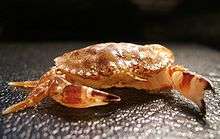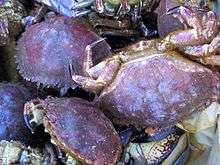Metacarcinus
Metacarcinus is a genus of crabs formerly included in the genus Cancer.[1] It includes nine exclusively fossil species and five extant species, of which four are also known from the fossil record.[2] The monophyly of this genus was not supported by a molecular study using the cytochrome oxidase I gene.[3]
| Metacarcinus | |
|---|---|
.jpg) | |
| Scientific classification | |
| Kingdom: | |
| Phylum: | |
| Subphylum: | |
| Class: | |
| Order: | |
| Infraorder: | |
| Family: | |
| Genus: | Metacarcinus A. Milne-Edwards, 1862 |
| Type species | |
| Metacarcinus magister Dana, 1852 | |
Description
Metacarcinus crabs have an oval carapace of about ⅔ of its largest width, with a surface with poorly marked division of smooth or gently colored regions. The front edge usually does not protrude before orbital, and the total length of these edges is 26-34% of the largest width of the carapace, with 5 spikes, including inner orbits, of which the middle springs lower than the others. 9-10 spikes are located on both anteroposterior lateral sides of the carapace; they can be of different shapes. The lateral edges are edged and can have one spike. The claws propodite is characterized by an upper edge at an angle of about 120° to the distal edge, equipped with sharp spines or grained or smooth keel. On the external surface of the propodite there are usually 4 balls. The cutting edges of the pliers' fingers of the claw have sharp teeth. The fixed finger has two points: middle and on the bottom edge
Extant species
Included species:[4]
| Image | Scientific name | Common Name | Distribution |
|---|---|---|---|
 | Metacarcinus anthonyi | yellow rock crab or yellow crab | Pacific coast of North America |
 | Metacarcinus edwardsii | mola rock crab, southern rock crab, or Chilean rock crab | Pacific coast between Guayaquil in Ecuador and the Beagle Channel in the southernmost Chile |
 | Metacarcinus gracilis | graceful rock crab or slender crab | from Alaska to Bahía Magdelena, Baja California |
 | Metacarcinus magister | Dungeness crab | west coast of North America |
 | Metacarcinus novaezelandiae | Pie crust crab | New Zealand and south-eastern Australia. |
Fossils
- † Metacarcinus danai (Miocene, California)
- † Metacarcinus davidi (Miocene to Pliocene, California)
- † Metacarcinus goederti (Oligocene, Alaska)
- † Metacarcinus izumoensis (Miocene, Japan)
- † Metacarcinus jenniferae (Middle Pliocene, California)
- † Metacarcinus minutoserratus (Pliocene, Japan)
- † Metacarcinus starri (Early Oligocene, Washington)
References
- P. K. L. Ng, D. Guinot & P. J. F. Davie (2008). "Systema Brachyurorum: Part I. An annotated checklist of extant Brachyuran crabs of the world" (PDF). Raffles Bulletin of Zoology. 17: 1–286. Archived from the original (PDF) on 2011-06-06.
- Sammy De Grave; N. Dean Pentcheff; Shane T. Ahyong; et al. (2009). "A classification of living and fossil genera of decapod crustaceans" (PDF). Raffles Bulletin of Zoology. Suppl. 21: 1–109. Archived from the original (PDF) on 2011-06-06.
- Michelle K. Harrison & Bernard J. Crespi (1999). "Phylogenetics of Cancer Crabs (Crustacea: Decapoda: Brachyura)" (PDF). Molecular Phylogenetics and Evolution. 12: 186–199. doi:10.1006/mpev.1998.0608. PMID 10381321.
- Carrie E. Schweitzer & Rodney M. Feldmann (2000). "Re-evaluation of the Cancridae Latreille, 1802 (Decapoda: Brachyura) including three new genera and three new species". Contributions to Zoology. 69 (4): 223–250. Archived from the original on 2012-12-09. Retrieved 2010-10-17. Also available as PDF.